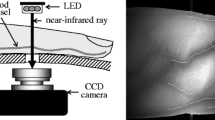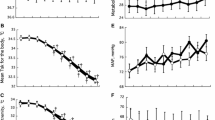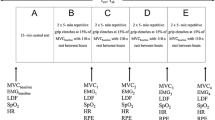Abstract
Effect of hypoxia (12% O2) on skin temperature recovery was studied on healthy young men. Forty male volunteers free of any respiratory disorder were randomly selected to participate in the study. Skin temperature, peripheral blood flow, heart rate and end expiratoryPO2 andPCO2 were measured. During hyoxic ventilation the peripheral blood flow was reduced and a corresponding drop in skin temperature occurred. This was partly due to hyperventilation associated with hypoxic ventilation. The recovery of skin temperature after cooling the hand for 2 min in cold water (10–12° C) took 5.5±0.1 min during normal air breathing; during hypoxic ventilation even after 9.1±0.3 min when the skin temperature recovery curve plateaued, the skin temperature remained about 2° C below control. The results of the present investigation indicate that hypoxia interferes with the normal functioning of the thermoregulatory mechanism in man. Hyperventilation associated with hypoxic ventilation is also partly responsible for incomplete recovery of skin temperature.
Similar content being viewed by others
References
Bhatia B, George S, Rao TL (1969) Hypoxia poikilothermia in rats. J Appl Physiol 27:583–586
Blood FR, Elliot RV, Amour FED (1946) The physiology of the rat in extreme anoxia. Am J Physiol 146:319–329
Durand J, Martineaud JP (1971) Resistance and capacitance vessels of the skin in permanent and temporary residents at high altitude. In: Porter R, Knight J (eds) High altitude physiology: cardiac and respiratory aspects. Ciba Foundation Symposium, Churchill Livingstone, Edinburgh, p 159
Durand J, Verpillat JM, Pradel M, Martineaud JP (1969) Influence of altitude on the cutaneous circulation of residents and newcomers. Fed Proc 28:1124
Gautier H, Bonora M (1979) Effects of carotid body denervation on respiratory pattern of awake cats. J Appl Physiol 46:1127–1131
Gautier H, Bonora M (1980) Possible alterations in brain monoamine metabolism during hypoxia-induced tachypnea in cats. J Appl Physiol 49:769–777
Gautier H, Bonora M, Schultz SA, Remmers JE (1987) Hypoxia-induced changes in shivering and body temperature. J Appl Physiol 62:2477–2484
Greenleaf JE, Greenlef CJ, Card DH, Saltin B (1969) Excercise — temperature regulation in man during acute exposure to simulated altitude. J Appl Physiol 26:290–296
Hassan AAK, Tooke JE (1988) Effect of changes in local skin temperature on postural vasoconstriction in man. Clin Sci 74:201–206
Heistad DD, Wheeler RC (1970) Effect of acute hypoxia on vascular responsiveness in man. J Clin Invest 49:1252–1265
Hemingway A, Birzis L (1956) Effect of hypoxia on shivering. J Appl Physiol 8:577–579
Hemingway A, Nahas GG (1952) Effect of hypoxia on the metabolic response to cold. J Appl Physiol 5:267–272
Hill JR (1958) The relation between oxygen consumption, hypoxia and environmental temperature. J Physiol 143:64–65
Hill JR (1959) The oxygen consumption of new-born and adult mammals. Its dependence on the oxygen tension in the inspired air and on the environmental temperature. J Physiol 149:346–373
Moore RE (1956) Hypoxia, oxygen consumption and body temperature in newborn kittens. J Physiol 133:69–70
Moore RE (1959) Oxygen consumption and body temperature in new-born kittens subjected to hypoxia and reoxygenation. J Physiol 149:500–518
Rai RM, Selvamurthy W, Purkayastha SS, Malhotra MS (1978) Effect of altitude acclimatization on thermoregulation efficiency of man. Aviat Space Environ Med 49:707–709
Roy SB, Guleria JS, Khanna PK, Talwar JR, Manchanda SC, Pande JN, Kaushik VS, Subba PS, Wood JE (1968) Immediate circulatory responce to high altitude hypoxia in man. Nature 217:1177
Snedecor GW, Cochran WG (1980) Statistical methods. Iowa State University Press, Ames, Iowa, pp 298–333
Tamaki Y, Nakayama T (1987) Effects of air constituents on thermosensitivities of preoptic neurons: hypoxia versus hypercapnea. Pflügers Arch 409:1–6
Tromp SW (1964) A simple water bath test for estimating the thermoregulation efficiency of man. J Biometeorol 7:291–296
Tromp SW, Bouma JJ (1974) The biological effects of natural and simulated high altitude climate on the physiological functions of healthy and diseased subjects (in particular asthmatics) Monograph Series Biometeorology Research Centre, Leiden, The Netherlands
Author information
Authors and Affiliations
Rights and permissions
About this article
Cite this article
Fahim, M. Effect of hypoxic breathing on cutaneous temperature recovery in man. Int J Biometeorol 36, 5–9 (1992). https://doi.org/10.1007/BF01208727
Received:
Revised:
Accepted:
Issue Date:
DOI: https://doi.org/10.1007/BF01208727




